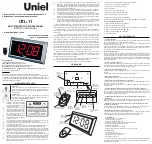
11
7. Recommended Locations for Smoke Alarms
•
Locate smoke alarms in all sleeping areas. Try to monitor the exit path as the bedrooms are usually farthest from the
exit. If more than one sleeping area exists, locate additional alarms in each sleeping area.
•
Locate additional alarms to monitor any stairway as stairways act like chimneys for smoke and heat.
•
Locate at least one alarm on every floor level.
•
Locate an alarm in every bedroom.
•
Locate an alarm in every room where electrical appliances are operated (i.e. portable heaters or humidifiers).
•
Locate an alarm in every room where someone sleeps with the door closed. The closed door may prevent an alarm
not located in that room from waking the sleeper.
•
Smoke, heat, and combustion products rise to the ceiling and spread horizontally. Mounting the smoke alarm on
the ceiling in the center of the room places it closest to all points in the room. Ceiling mounting is preferred in
ordinary residential construction.
ANYWHERE ALONG
THIS BOLD SURFACE
Locations permitted for smoke
alarms and smoke detectors
on tray-shaped ceilings.
ANYWHERE ALONG
THIS BOLD SURFACE
Locations permitted for smoke
alarms and smoke detectors
on tray-shaped ceilings.
ANYWHERE ALONG
THIS BOLD SURFACE
Locations permitted for smoke
alarms and smoke detectors
on tray-shaped ceilings.
ANYWHERE ALONG
THIS BOLD SURFACE
Locations permitted for smoke
alarms and smoke detectors
on tray-shaped ceilings.
ANYWHERE ALONG
THIS BOLD SURFACE
Locations permitted for smoke
alarms and smoke detectors
on tray-shaped ceilings.
ANYWHERE ALONG
THIS BOLD SURFACE
Locations permitted for smoke
alarms and smoke detectors
on tray-shaped ceilings.
NFPA 72 states: “Smoke alarms in rooms with ceiling
slopes greater than 1 ft in 8 ft (.3m in 2.4 m) horizontally
shall be located on the high side of the room.” NFPA 72
states: “A row of detectors shall be spaced and located
within 3 ft (0.9m) of the peak of the ceiling measured
horizontally.”
Figure 7-A
Figure 7-B
Figure 7-C












































